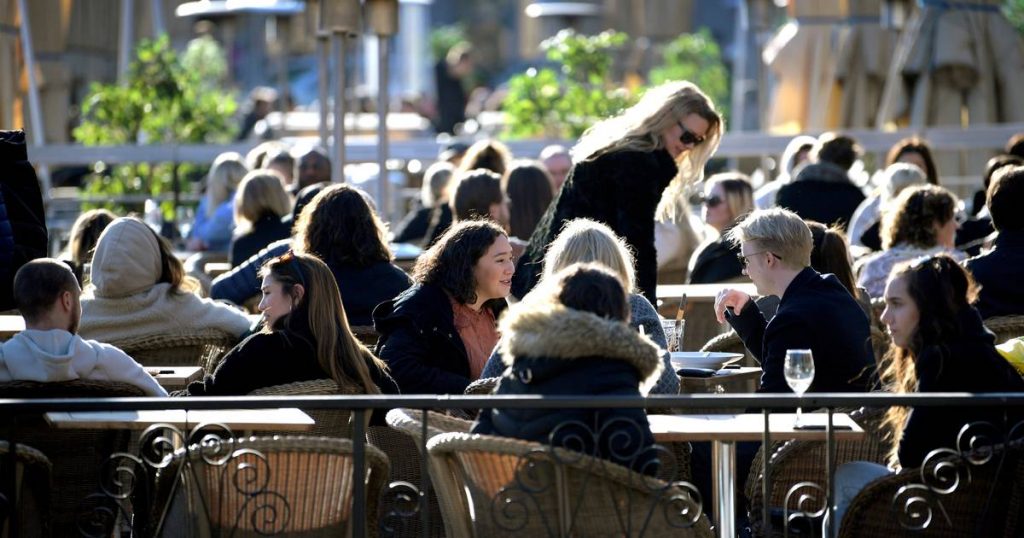The ranking of European countries with the worst Corona numbers has a new leader. As of Friday, the worst student in the class has been the country that does not believe in lockdowns and appeals to citizens’ sense of responsibility to control the pandemic, with recommendations rather than coercive measures: Sweden.
But the first good news. Overall, things are going in the right direction with the Corona numbers in Europe. They still account for about half of what we’ve seen during the great peaks of the pandemic. Belgium is in 14th place, and therefore in the middle of the ranking.
This classification has a new leader since Friday. This is evident from the figures from the statistical site Our world in data, Which is also used by the World Health Organization (WHO). Sweden took the lead from Cyprus and before that Hungary, which is remarkable, because the Scandinavian country had a very separate strategy against Coronavirus during the crisis.
Group immunity
Sweden does not believe in strict lockdowns, as we have seen in her country, France and Germany. At the start of the epidemic, the Folkhälsomyndigheten Health Institute (FHM) – the Swedish version of Sciensano – did its best for an approach that actually focused on herd immunity. In fact, the virus was allowed to go its own way. For example, mouth masks were not used and, for example, no measures were taken for public transportation, restaurants and shopping. The number of people allowed to gather in all types of activities was set to a maximum of 50 at the end of March.
As a result, Sweden has already topped the ranking of countries with the worst rates of coronavirus in Europe for the first time between May 8 and July 4. The numbers were still much lower than during subsequent waves, reaching at its highest point just over 100 new cases per million people over a period of seven days. In comparison, in the second wave, the peak in Europe was over 1500.
Over the summer, the numbers in Sweden remained under control, but took off again at the end of October – as in many other European countries. Earlier that month, Sweden relaxed its few measures, allowing, for example, 300 people to meet again.
Mond masks
A second, larger wave appeared and peaked twice: once at the end of December and once at the beginning of January. Face masks appeared suddenly in nursing homes and other care settings and on January 7 they were “sometimes recommended” on public transport. In November, there was a ban on selling and serving alcoholic beverages after 10 PM, and it was tightened at 8 PM at the end of December. Secondary education moved to distance learning in early December, and the number of people allowed to meet again decreased, including in bars and restaurants.
In the second half of January, the numbers started to decline, but soon they got stuck at a fairly high level. Higher than ours. In mid-February, the reversal movement started again and the numbers slowly rose again. Until they reached the highest level in all of Europe on Friday.
On that day, 7,772 new infections and 26 new deaths were reported in a country of 10 million people. For comparison: In our country (which has a population of 11.6 million), an average of 3,592 new cases of corona and 39 deaths from the Corona virus were counted that day. It must be said that Sweden, with an area of 450,000 square kilometers, is much wider than Belgium (30,000 square kilometers). Thus the population density is much lower than in our country and there is also much less international transit.
According to the latest WHO figures, 857,401 confirmed cases of corona have been recorded in Sweden since the beginning of the epidemic, and 13,621 deaths. The number of confirmed cases in Belgium reached 922,487 and 23,428 deaths, respectively, according to the World Health Organization (figures from Sunday). The number of deaths per capita is much higher in Sweden than in other Scandinavian countries, but lower than most of Europe. The latter is indicated by figures from the European Statistical Office Eurostat.
Vaccination campaign
The Swedish government and health authorities have already acknowledged their failure to protect the elderly population, but insisted that they did what they could to fight the virus. Meanwhile, the vaccination campaign is in full swing. At the beginning of this month there was a setback on that front. Initially, the government promised that all adults who wanted to be vaccinated (in part) by the end of June, but that date has now been pushed back by two months. The new target is August 15th. Delay in delivery is given as a reason, particularly on AstraZeneca.
Educational advice: “Schools want stability”
Unlimited free access to Showbytes? Which can!
Sign in or create an account and don’t miss the chance to star.

“Coffee buff. Twitter fanatic. Tv practitioner. Social media advocate. Pop culture ninja.”















More Stories
Strong increase in gas export pipeline from Norway to Europe
George Louis Bouchez still puts Julie Tatton on the list.
Thai Air Force wants Swedish Gripen 39 fighter jets